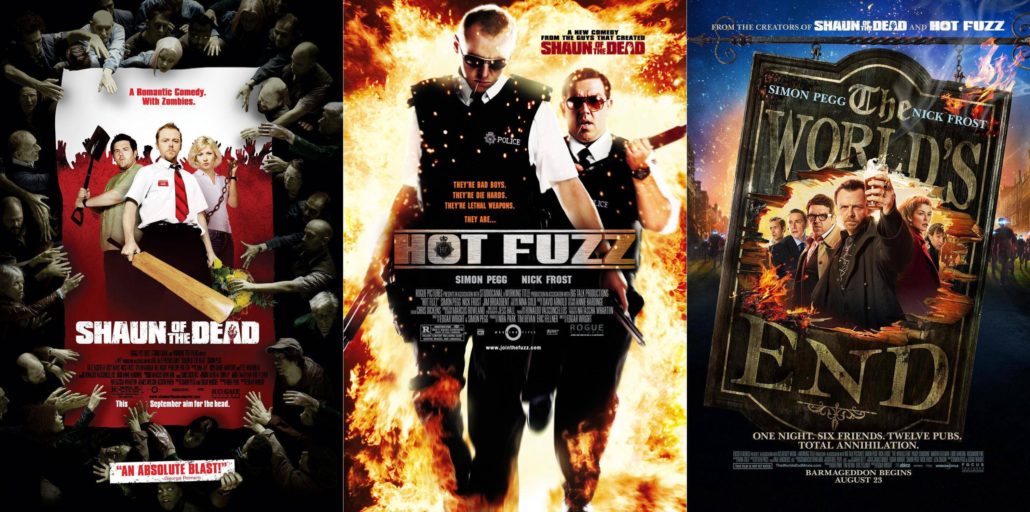
This feature will contain spoilers.
I was 13 when the sitcom Spaced landed on Channel 4. And though many of the references and much of the drug humour went over my head, it still made an impression on me. Mainly because it looked like no other comedies. Whilst most were three walls, mid-range camera angles and an audience laughing over it, this was far more dynamic. Director Edgar Wright’s wild editing, nack for weird angles and his ability to mimic famous shots gave the show a cinematic quality rarely seen on telly. As such, it was inevitable his vision would leave the small screen for the big one. Five years later he’d collaborated again with Simon Pegg, one of the two writers and costars, and supporting actor Nick Frost for the first of three films that’d span genres and styles: Shaun of the Dead. The series would continue in 2007, with cop comedy Hot Fuzz, and then reach its apocalyptic finale in 2013 with the aptly titled The World’s End.
Part of what makes Pegg, Wright and Frost such an appealing trio is, more so than any other team of collaborators, they seem like they could be us. As movie fanboys who became movie makers, their encyclopaedic knowledge of cinema underlines into almost every scene be it through clever little nods, direct references or cameos. Hence as well as being great movies in their own right, they are star-studded love-letters to the ones they grew up on. After discussing the trilogy recently, I thought it’d be fun to rank them. But having not seen them for a few years I needed to watch them again in all their fast cutting, fence jumping, fruity playing glory. So with the sorts of lager and junk-food, Shaun and Ed would approve of, plus the obligatory Cornetto, me and The Guys™ had all three scoops in one sitting.
Note that while I’ve known for ages what my winner is, and last night’s rewatch did nothing to change this, it was and still is very close between the other two. But I should say that all three are excellent movies in their own right, and unlike any other series I can think of, there’s really no consensual wrong answer to the question of which is best. Still, that qualifier out the way, let me tell you how I’d rank them and why you should all agree with me. There’s a lot to get through, so let’s boo boo.
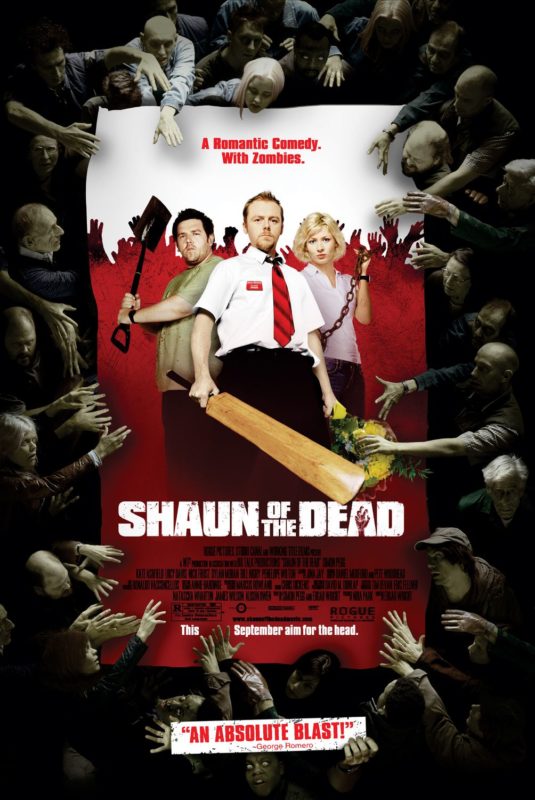
3. Shaun of the Dead: the red Cornetto. Modern London is overrun by zombies (but don’t use that word!). Not that TV salesman Shaun notices at first, with the deadheads not standing out from the uninspired, lifeless commutators he spends every waking day with. Coming out around the same time as Zack Snyder’s Dawn of the Dead remake, this was arguably the more faithful follow-up. It’s scrappy combat, shuffling zombies and focus on social comment were all out the Romero playbook. As with its source materials, the Zombies are a metaphor. This time they stand-in for the boredom and emptiness of modern life: a cyclical existence that leaves people disconnected from one another.
Yet where Romero was a cynic, with the zombies being used to explore humanity at its most violent and selfish, Shaun is way more optimistic, using them to bring out the best in people. Beneath the violent exterior, there’s a sappy, coming of age movie that eventually claws its way to the surface. Its titular character grows as a consequence of said apocalypse, learning to take responsibility, realise who/ what is important in life and to leave the same tired cycles. Put simply, it takes the undead rising to make him feel alive. As his favourite bar burns to the ground, with the pal who has been holding him back inside, it seems the end of that life for him. He’s now a better man, a better son and a better partner. Yet while Shaun’s relationships with his mum and girlfriend are maybe the most important to the film’s meaning, it’s his one with his fuck-up friend Ed that’s ultimately most rewarding. Real-life besties Pegg and Frost have easy chemistry which gives their immature banter an authenticity and charm that can’t be easily faked. Sure, we want Shaun to change – but not too quickly! Ed may a total liability, but he’s also hilarious. Whether it’s playing video games, rapping or laughing at each other’s farts, it’s a gleefully juvenile pairing with an energy that’s contagious. This means Shaun negotiating a compromise between bromance and romance isn’t as easy as just ditching him. Hence the last scene where he’s found a balance, even of it means lying to Liz, is so perfectly judged: the audience get what they want and he gets what he needs.
Most importantly, of course, it’s bloody good fun. Scenes like the guys deciding which vinyls to throw at the hoard, or a reanimated barman getting beaten with pool cues to the tune of Don’t Stop Me Now, have rightfully become iconic. Then there’s the sick satisfaction of watching Dylan Moran (who is deliciously dickish as David) undergo the most violent death in the movie. It’s also arguably the funniest of the three, with its highly quotable script delivering at least a laugh a minute. Yet on balance, I think it’s the lesser of them. This isn’t much of a slight since it’s by no means a weak film – and it wins a place on any respectable top 10 horror-comedies of all time and established the zom-com as a sub-subgenre. But unlike the others, for me it doesn’t quite get the balance between engaging with the subgenre it’s riffing on and laughing at it. The zombies are basic, and the spoofy reliance of slapstick means the film never sells them as much of a threat. In contrast, its sequel celebrates a type of film so close to self-parody and plays it so seriously, that it only watches like a slightly exaggerated version of the real thing. Speaking of which…
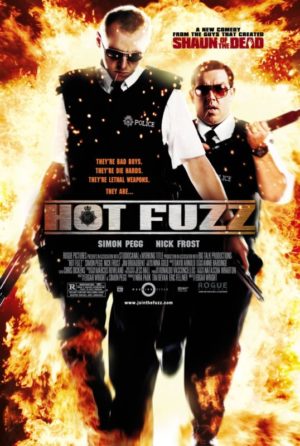
2. Hot Fuzz: the blue Cornetto. As per Shaun, this one repeats the trick of taking Hollywood to England. Only this time we leave the London suburbs in favour of the small, fictional village of Sandford, where the biggest problems are runaway swans and vigilante street performers. It’s the new home for stick-up-his-arse supercop Nicholas Angel, who is forced out of the London Met for being too good. This leads to an accomplished fish out of water comedy first act, before a village-wide conspiracy bleeds into the second and gives way for an excessive action movie finale. It’s The Wickerman meets Bad Boys, as between the intrigue and gunfights, Angel learns to find a better work-life balance, starts to appreciate action flicks and even makes a new friend.
Angel getting better at switching off, and warming to his new life is the film’s emotional centre. It’s arguably less weighty than either of the others, but still a neat throughline. But with Pegg playing him as being as straight as a straight man can be, it’s up to the supporting cast to earn the big laughs, with him generously giving them the best lines. Frost excels as Danny, a simple and loveable cop whose seen one too many movies. Paddy Considine and Rafe Spall are hilarious as the Andes: two patronising bastards with an immediate dislike for Angel’s by the book style and him being “such a big fan of murder”. Olivia Coleman is hilarious as a double entendre spouting “policewoman”, who takes the PC out of the service. Still, the best performer is Timothy Dalton, who’s Simon Skinner isn’t hiding in plain sight as much as relishing in his guilt with constant thinly-veiled threats. Every scene he appears in is laugh-out-loud funny, and the sheer joy he takes in the part is a delight to watch. You almost don’t want him to get the gratuitously gory comeuppance he does. Perhaps my favourite performance in all of the films.
It was close between this and Shaun of the Dead for the second spot. Yet with numerous clever callbacks, and foreshadowing Hot Fuzz just cinches it. Of the three, it benefits the most from rewatches because Pegg and Wright’s script sets up so many little rewards for later on, with Angel doing lots of ironic quips and kills. But as well as being funny, Hot Fuzz totally delivers as an action film. Wright’s direction is also top-notch, with the adrenaline-rousing shoot outs and car chases looking as polished as they ever have. By shooting these over the top scenes as they should be, rather than the joke being how bad they look, he achieves a rare balance of being both self-aware and completely sincere. Wright and Pegg famously said that during the writing process they had a list of action movie tropes, and included every single one of them. It’s fine attention to detail, and when it ends with no cliché unturned its hard not to feel completely satisfied. The last half hour isn’t just one of the best half hours in comedy, but also in action. Still, and I appreciate the value I place on this is entirely subjective, the lack of heart means it finishes below…
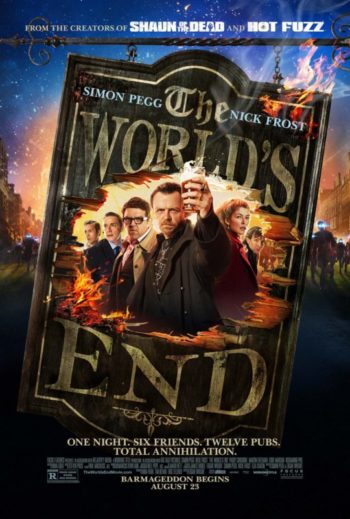
1.The World’s End: the green Cornetto. My least favourite ice cream, but my favourite film. I’d like to emphasise again that I love all three. But as a viewer, I’m most interested in characterisation. So for my top spot, I’ve picked this past one’s prime tragi-comedy. As with the others, this is a small-scale stab at something big budget: a paranoia science fiction thriller, taking place in a village in Hertfordshire. Also as per the others, Pegg is the protagonist, this time playing Gary King: a needy, self-destructive alcoholic who doesn’t want to grow up. After realising, during a rehab meeting, that the best day of his life was an unfinished pub crawl from two decades ago he decides to finish it once and for all. This means rounding his old friends back up for The Golden Mile: 12 pints in 12 pubs. Only you can never truly go home again, and their former stomping ground of Newton Haven has changed. For a start, the pubs look the same, the locals are acting weird and it’s become a lot more alien. Think of it as a dark twist on Peter Pan by way of Invasion of the Body Snatchers.
The first thing that jumps out about the World’s End is its the most visually impressive of the series. Wright’s fight coordination is excellent, with the camera drifting all around the room in a single cut. And though the martial arts sequences aren’t quite John Wick, each is carefully choreographed to be organised chaos. The “blanks”, as they are named following a pedantic discussion of robots and pronouns, also look stellar, with the blue lights they send out and their ink blood being very cool design features (supposedly the ink is to recall it getting everywhere at school – more being stuck in the last). There are also some excellent sets utilised throughout, with the underground layer, the titular end of the world and the medieval-like society it births all looking great. Then there’s the soundtrack! The greatest hits of the early 90s provide the perfect backdrop to five ageing men running for their lives down memory lane. But as well as looking and sounding stunning, it also the smartest of the three, the most emotionally complex and has by far the most to say.
As can be expected by now, you got tonnes of callbacks and foreshadowing (most obviously, the pub names signpost what happens in them). However, I’ve never thought The World’s End is especially funny. Even if there are individually great lines (“you’re drinking rain!”) it’s too tragic. This is perhaps inevitable, given for the first three quarters the script asks us to pity it’s leading man more than we empathise with him. Gary King is by some distance the most interesting and complex Pegg protagonist: really annoying, and manipulative, but also just sad. His fixation on yesteryear is apparent from his now faded black dyed hair to him driving the same car since 1989 (The Beast). He peaked early and never moved on. The others still have ties to 1990, be it the people who used to bully them or girls they used to like. But for them, the crawl is a nostalgic break from their daily lives – something visualised with now established actors being lured back to the pub, and this series, by Pegg. They maybe get on best when they’re saying things that start with “remember when”, but they all have somewhere else they could be. However, for Gary, it’s a headspace he never left, even though the world he clings to has long since ceased to exist. Heck, he’s still trying to live in it once it’s been decimated (though he orders water – it’s not much, but at least there’s progress). Not that he’d say things are different now since acknowledging this would mean he’s no longer cool, and even worse that he needs to change. Which brings us to the next big focus: conformity. The parallel between the town gradually becoming like all others, and them transitioning from idealistic teens into new corporate workers, is well handled. As we age we become people our teenage selves wouldn’t necessarily want to be. This means there’s a realism to a set of friends outgrowing each other, with their early conversations mimicking the sorts of networking they all likely do now professionally (they even exchange cards).
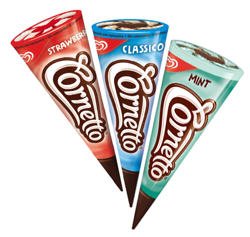
The film’s concerns with losing one’s individual identity as part of a collective are arguably in the DNA of all three entries. But they are most pronounced here: being integrated into the plot, the setting, the drama, the visual gags and The Network’s motivation. They are brought to a climax in the surprisingly emotional scene in the final pub in which Gary and Andy talk it out: what they thought life would be vs what it is. It’s angry on one side, tender on the other and completes the series maturation from the maker’s care-free mid-twenties to their more reflective thirties and forties. Like many viewers, I’ve grown with them – going from days of munching kebabs on a sofa waiting for life to happen, to being in a career and dreading the hangover after the increasingly more occasional night of drinking. As such, it’s a trilogy I’ve got lots of time for and I’m glad to have revisited it after years away. Unlike Gary King, I’m glad I can go back whenever I want.

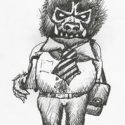
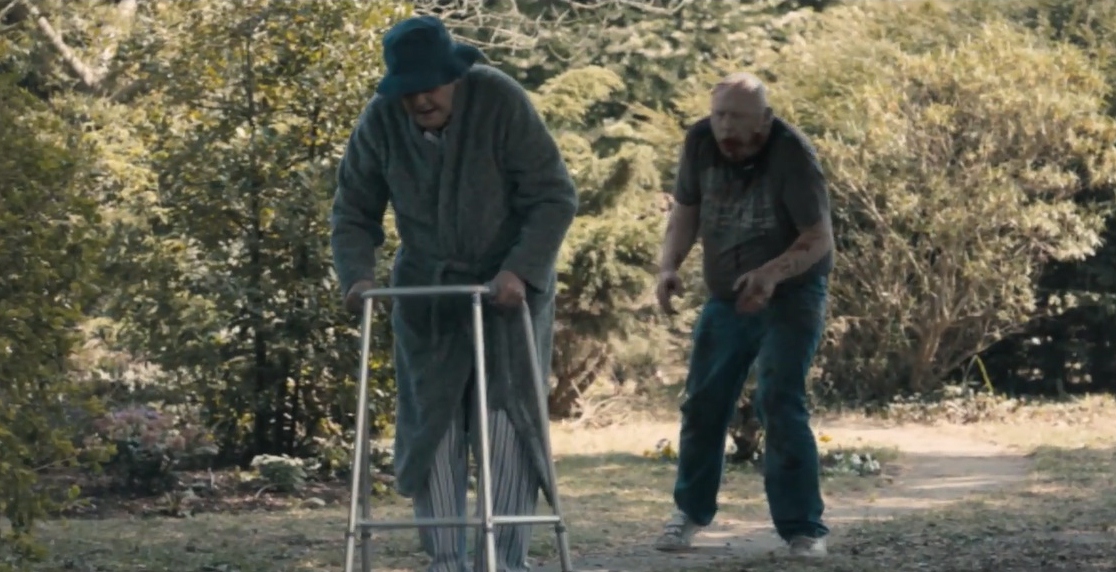
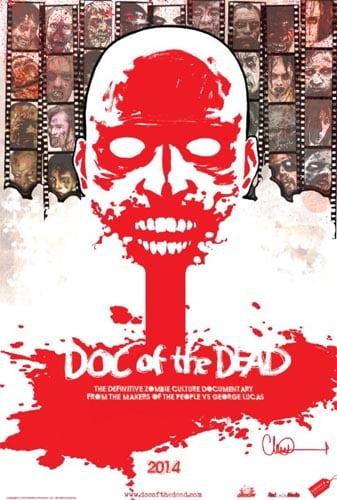
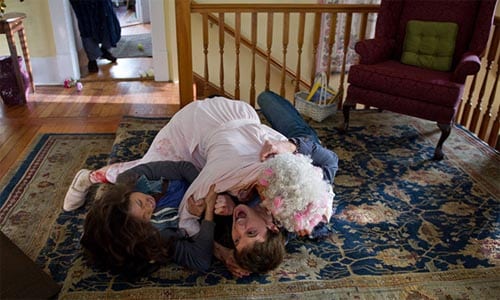
Be the first to comment